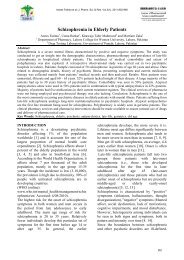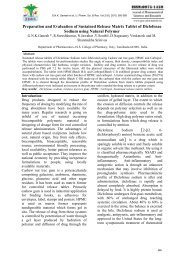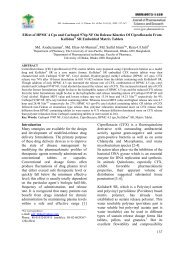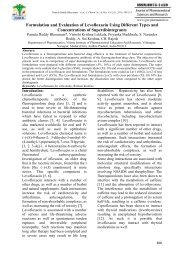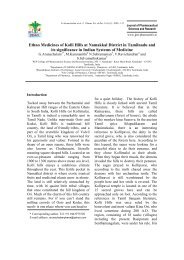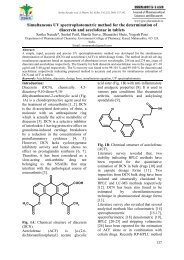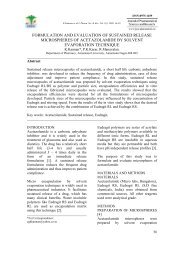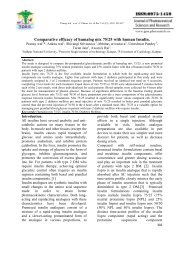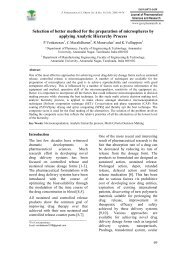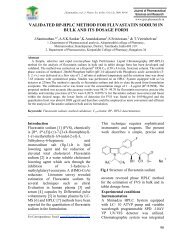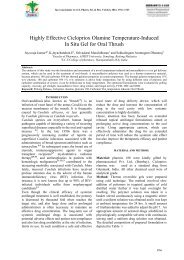Pharmacognostical standardization of leaves of Ixora coccinea, linn.
Pharmacognostical standardization of leaves of Ixora coccinea, linn.
Pharmacognostical standardization of leaves of Ixora coccinea, linn.
Create successful ePaper yourself
Turn your PDF publications into a flip-book with our unique Google optimized e-Paper software.
R. Vadivu et al, /J. Pharm. Sci. & Res. Vol.2(3), 2010, 164-170<br />
<strong>Pharmacognostical</strong> <strong>standardization</strong> <strong>of</strong> <strong>leaves</strong> <strong>of</strong> <strong>Ixora</strong> <strong>coccinea</strong>, <strong>linn</strong>.<br />
R. Vadivu*, N.Jayshree, C.Kasthuri, K.Rubhini and G.Rukmankathan<br />
College <strong>of</strong> Pharmacy, Madras Medical College, Chennai-03, India.<br />
Abstract<br />
<strong>Ixora</strong> <strong>coccinea</strong> Linn. is traditionally found to be useful for many ailments like hepatoprotective, Chemoprotective ,<br />
antimicrobial, anti oxidant , antinociceptive and anti – inflammatory activities. The present study highlights the<br />
botanical as well as phytochemical studies including parameters such as macroscopic, microscopic characters,<br />
physiochemical evaluation and preliminary phytochemical studies <strong>of</strong> the <strong>leaves</strong>. These observations will help in the<br />
botanical identification and <strong>standardization</strong> <strong>of</strong> the drug in the crude form and also to distinguish the drug from its<br />
adulterants<br />
Introduction:<br />
<strong>Ixora</strong> <strong>coccinea</strong> Linn., (Rubiaceae) is Known<br />
as ‘ Jungle <strong>of</strong> Geranium (or) Flame <strong>of</strong> the<br />
woods or vetchi ‘ in Ayurvedha . It is a<br />
common flowering shrub native to Asia. It is<br />
name derived from an Indian deity.<br />
Although there are some 400 species in the<br />
genus <strong>Ixora</strong> , only a handful are commonly<br />
cultivated. And the common name , <strong>Ixora</strong> is<br />
usally used for <strong>Ixora</strong> <strong>coccinea</strong>, is a dense,<br />
multi – branched ever green shrub<br />
commonly 4-6 ft (1-2-2m) in height, but<br />
capable <strong>of</strong> reaching up to 12ft (3.6m) hight.<br />
It is traditionally used as hepatoprotective,<br />
Chemoprotective , antimicrobial, anti<br />
oxidant , antinociceptive, anti – mitotic and<br />
anti – inflammatory activities. Decoction <strong>of</strong><br />
roots used for nausea, hiccups and<br />
anorexia.Powered roots used for sores and<br />
chronic ulcers In indo – china , root<br />
decoction used to clarify the urine, poultice<br />
fresh <strong>leaves</strong> and stems for sprains, eczema,<br />
boils and contusions[1,2] .<br />
Eventhough the plant is rich in bio-active<br />
richness active constituents and potential<br />
therapeutic activities there is a lacuna in the<br />
<strong>Pharmacognostical</strong> <strong>standardization</strong> on the<br />
<strong>leaves</strong> <strong>of</strong> <strong>Ixora</strong> <strong>coccinea</strong> Linn. So the<br />
present study is undertaken to produce some<br />
<strong>Pharmacognostical</strong> standards for the <strong>leaves</strong>.<br />
Materials and Methods:<br />
The fresh healthy plant material <strong>of</strong> <strong>Ixora</strong><br />
<strong>coccinea</strong> Linn., was collected from various<br />
domestic places in Chennai and<br />
authenticated by Pr<strong>of</strong>. P. Jayaraman, Ph.D,<br />
Botanist, Director , Plant Anatomy Research<br />
Centre, Thambaram. A voucher specimen is<br />
deposited in the department <strong>of</strong><br />
Pharmacognosy, Madras Medical College,<br />
Chennai-03 for future reference. The fresh<br />
<strong>leaves</strong> were collected and fixed immediately<br />
using FAA (formalin: Acetic acid: ethyl<br />
alcohol) as fixative agent for anatomical<br />
studies. The materials were cut into small<br />
pieces before fixing.<br />
Macroscopic and microscopic analysis<br />
The macroscopic characters such as colour ,<br />
odour, taste, nature, texture were studied for<br />
morphological investigation. For anatomical<br />
studies customary technique <strong>of</strong> microtmy<br />
was followed[3]. Paraffin sections <strong>of</strong> 10µm<br />
thick were stained with safranin – fast green.<br />
Photomicrography were taken with Nikon<br />
lab photo – microscopic unit .The<br />
quantitative microscopy was studies as per<br />
the procedure given by Wallis[4] and<br />
P.K.Lala[5]. The powder analysis has been<br />
carried out according to the method <strong>of</strong> Brain<br />
and Turner[6].<br />
Physico – chemical studies<br />
The ash values, extractive values and loss on<br />
drying were performed according to the<br />
<strong>of</strong>ficinal methods prescribed in Indian<br />
pharmacopeia[7] and the WHO[8]<br />
guidelines on quality control methods for<br />
medicinal plants materials. Fluorescence<br />
analysis was carried out according to the<br />
method <strong>of</strong> Chase and Pratt[9] and Kokoski<br />
[10] .<br />
Preliminary phytochemical screening<br />
The dried <strong>leaves</strong> were extracted with<br />
petroleum ether, chlor<strong>of</strong>orm, ethylacetate<br />
and methanol. The behavior <strong>of</strong> powder with<br />
various chemical reagent and preliminary<br />
164
R. Vadivu et al, /J. Pharm. Sci. & Res. Vol.2(3), 2010, 164-170<br />
chemical tests for various extracts were also<br />
carried out according to the standard<br />
procedures described by Kokate[11] and<br />
Horborne[12].<br />
Results:<br />
Macroscopy<br />
The plant is a dense, multi – branched<br />
evergreen shrub, commonly 4-6 ft (1-2-2m)<br />
in height , but capable <strong>of</strong> reaching up to 12ft<br />
(3.6 m). Leaves are oblong are about 10cm<br />
long , with entire margins and are carried in<br />
opposite pairs or whorled on the stem. They<br />
are sessile to short – petiolate, blades<br />
elliptic, oblong or obovate, usually leathery,<br />
base cordate to rounded, apex rounded ,<br />
mueronate or shortly tapering ; stipules<br />
basally sheathing , lobes Triangular and<br />
strongly acon – tipped. Flowers sessile;<br />
calyx lobes short, triangular, persistent ,<br />
corolla tube usually 1-1.5 inches long , lobes<br />
lanceolate to ovate, less than 0.25 inches<br />
long , acute or sometimes obtuse fruit thinly<br />
fleshy , reddish black.<br />
Microscopic features <strong>of</strong> the <strong>leaves</strong><br />
Microscopical studies are useful to establish<br />
the botanical identity for the valuable herbal<br />
drugs, which forms the basis for the<br />
identification and determination <strong>of</strong><br />
adulterants.<br />
The leaf is dorsiventral, hypostomatic and<br />
mesomorphic. It has thick midrib projecting<br />
both adaxially and abaxially (fig 1).The<br />
midrib has adaxial broadly conical hump<br />
and wide semicircular abaxial past. The<br />
midrib is 1.1 mm thick. The adaxial past is<br />
400µm wide. The abaxial part is 900 µm<br />
thick.<br />
The epidermal layer <strong>of</strong> thin midrib consists<br />
<strong>of</strong> small, squarish, thick walled cells with<br />
prominent cuticle, the cells are with<br />
prominent cuticle and the cells are 22 µm<br />
thick. Beneath the adaxial hump is a small<br />
patch <strong>of</strong> angular, compact thick walled cells,<br />
the palisade layer <strong>of</strong> the lamina extend up to<br />
the lateral part <strong>of</strong> the hump (fig.2)<br />
The lower semicircular midrib has<br />
parenchymatous ground tissue. The cells are<br />
wide thin walled, angular and compact.<br />
Calcium oxalate are occasionally seen in<br />
some <strong>of</strong> the parenchyma cells (fig.4)<br />
The vascular system <strong>of</strong> the midrib consists<br />
<strong>of</strong> an adaxially flattened closed cylinder <strong>of</strong><br />
xylem and phloem ; with in the cylinder are<br />
two small rectangular segments <strong>of</strong> vascular<br />
bundles. The outer cylinder has a thin layer<br />
<strong>of</strong> xylem fibres and short radial files <strong>of</strong><br />
narrow, thick walled angular xylem<br />
elements and outer continuous zone <strong>of</strong><br />
phloem.<br />
Hedullary accessory bundles are collateral<br />
with xylem elements facing the adaxial side<br />
and phloem elements placed toward the<br />
centre. The vascular cyclinder is 170 µm<br />
thick. The xylem elements are 20µm wide.<br />
Lamina (Fig 5) : The lamina has wide ,<br />
radially oblong thick walled adaxial<br />
epidermis with prominent cuticle. The<br />
adaxial epidermis is 40 µm thick. The<br />
abaxial epidermis has comparatively small<br />
cells which are squarish in shape, the cuticle<br />
is thicker; stomata are present on the lower<br />
epidermis.<br />
These are two layers <strong>of</strong> palisade cells along<br />
the upper part. The cells are wide,<br />
cyclindrical and the palisade zone in 60µm<br />
in height. The spongy parenchyma cells are<br />
in 4 (or) 5 rows. They are large thin<br />
traveled, spherical lobed and form wide air –<br />
chambers (fig – 6)<br />
The vascular strands <strong>of</strong> the lateral veins are<br />
circular with thick cylinder <strong>of</strong> fibers and<br />
small central case <strong>of</strong> xylem and phloem.<br />
Quantitative microscopy<br />
Quantitative microscopy<br />
Quantitative microscopic data are found to<br />
be constant for a species. These values are<br />
especially useful for identifying the different<br />
species <strong>of</strong> genus and also helpful in the<br />
determination <strong>of</strong> the authenticity <strong>of</strong> the<br />
plant. The study <strong>of</strong> the leaf constants<br />
showed that the average stomatal number is<br />
165
R. Vadivu et al, /J. Pharm. Sci. & Res. Vol.2(3), 2010, 164-170<br />
24mm 2 , the stomatal index is 12.2mm 2 . The<br />
vein islets number and vein termination<br />
numbers are 13.5mm and 26.3mm/sqmm<br />
respectively. The palisade ratio is 9.3. The<br />
microscopic linear easurement <strong>of</strong> the<br />
trichomes showed that the length <strong>of</strong> the<br />
trichome is 44-65μm and the width is<br />
around 20 -24μm (Table no1).<br />
Powder characters<br />
The powder characters <strong>of</strong> a drug are mainly<br />
used in the identification <strong>of</strong> the drug in the<br />
powder from. The leaf powder was light<br />
green in colour with strong and<br />
characteristic in taste on microscopical<br />
examination the powder showed thick<br />
cylinder <strong>of</strong> fibers, anisocytic stomata,<br />
unicellular covering trichomes.<br />
Physico-chemical constants<br />
The physico-chemical parameters are mainly<br />
used in judging the purity and quality <strong>of</strong> the<br />
drug. Ash values <strong>of</strong> a drug give an idea <strong>of</strong><br />
the earthy matter or inorganic composition<br />
or other impurities present along with the<br />
drug. The ash values <strong>of</strong> the powdered <strong>leaves</strong><br />
revealed a high percentage <strong>of</strong> sulphated ash.<br />
Extractive values give an idea about the<br />
chemical constituents present in the drug as<br />
well as useful in the determination <strong>of</strong><br />
166
R. Vadivu et al, /J. Pharm. Sci. & Res. Vol.2(3), 2010, 164-170<br />
exhausted or adulterated drugs. The results<br />
suggest that the powdered <strong>leaves</strong> have high<br />
water soluble extractive value. The loss on<br />
drying reveals the percentage <strong>of</strong> moisture<br />
present in the drug are also studied and<br />
presented in (Table no 2).<br />
Fluorescence analysis <strong>of</strong> drug powder and<br />
extracts:<br />
The fluorescence analysis <strong>of</strong> powdered<br />
<strong>leaves</strong> was studied in both UV and day light.<br />
The powder showed green fluorescence with<br />
methanol in UV light at 254nm, which<br />
indicates the presence <strong>of</strong> chormophore in the<br />
drug (Table No. 3 & 4 )<br />
Extraction <strong>of</strong> phytoconstituents<br />
The dried <strong>leaves</strong> are extracted with<br />
petroleum ether, cholor<strong>of</strong>orm, ethylaceate<br />
and methanol. The extractive values are<br />
given in table no . the percentage yield <strong>of</strong><br />
methanolic extract is more when compared<br />
to other extracts (Table no.5).<br />
167
R. Vadivu et al, /J. Pharm. Sci. & Res. Vol.2(3), 2010, 164-170<br />
TABLE - 4<br />
Fluorescence analysis <strong>of</strong> drug powder <strong>of</strong><br />
<strong>leaves</strong> <strong>of</strong> <strong>Ixora</strong> <strong>coccinea</strong> Linn<br />
S.No. Treatment Day light UV light<br />
1. Powder<br />
2.<br />
3.<br />
4.<br />
5.<br />
6.<br />
7.<br />
8.<br />
9.<br />
10.<br />
Powder +<br />
water<br />
Powder +<br />
IN HCl<br />
Powder +<br />
IN HNO 3<br />
Powder +<br />
IN H 2 SO 4<br />
Powder +<br />
IN NaOH<br />
Powder +<br />
Alc. NaOH<br />
Powder +<br />
IN KOH<br />
Powder +<br />
AIc. KOH<br />
Powder +<br />
Ammonia<br />
Greenish<br />
brown<br />
Yellowish<br />
green<br />
Yellowish<br />
green<br />
Light<br />
brown<br />
Pale<br />
brown<br />
Yellowish<br />
brown<br />
Dark<br />
brown<br />
Yellowish<br />
brown<br />
Light<br />
brown<br />
Yellowish<br />
brown<br />
Pale<br />
green<br />
Dark<br />
green<br />
Green<br />
Green<br />
Pale<br />
Green<br />
Blackish<br />
green<br />
Dark<br />
green<br />
Blakish<br />
green<br />
Green<br />
Dark<br />
green<br />
Fig .3. T.S. <strong>of</strong> Leaf through Midrib with<br />
Lamina<br />
Preliminary phytochemical test for<br />
extracts<br />
All the extracts namely hexane, chlor<strong>of</strong>orm,<br />
ethanol and aqueous were tested with<br />
various reagents and results are presented in<br />
the (Table no.6). the various extracts showed<br />
the presence <strong>of</strong> alkaloids, carbohydrates,<br />
glycosides, flavanois and phytostrols.<br />
Fig .4. T.S. <strong>of</strong> midrib - Enlarged<br />
Abe – Abaxial Epidermis<br />
Abmr – Abaxial midrib<br />
Adh –Adaxial hump<br />
Gp – Ground Parenchyma<br />
La – Lamina<br />
MB – Medullary accessory bundle<br />
Ph – Phloem<br />
VC – Vascular Cylinder<br />
X – Xylem<br />
Ade - – Adaxial epidermis<br />
168
R. Vadivu et al, /J. Pharm. Sci. & Res. Vol.2(3), 2010, 164-170<br />
Fig .5. T.S. <strong>of</strong> Lamina<br />
Fig .6. T.S. <strong>of</strong> Lamina through Lateral<br />
Vein<br />
Abe – Abaxial epidermis, Ade – Adaxial<br />
epidermis, Cu – cuticle, Dr – Druses, Fi -<br />
Fibres, Pm – palisade mesophyll, Sm –<br />
Spongy mesophyll, St – stoma.<br />
169
R. Vadivu et al, /J. Pharm. Sci. & Res. Vol.2(3), 2010, 164-170<br />
Conclusion:<br />
Establishing standars is an integral part <strong>of</strong><br />
establishing the correct identity and quality<br />
<strong>of</strong> a crude drug. Before any drug can be<br />
included in the pharmacoparia, these<br />
standars must be established. The majority<br />
<strong>of</strong> the information on the identity, puring<br />
and quality <strong>of</strong> the plant material can be<br />
obtained from its macroscopy, microscopy<br />
and physio – chemical parameters . As there<br />
is no record on pharmacognostical work on<br />
<strong>leaves</strong> <strong>of</strong> <strong>Ixora</strong> <strong>coccinea</strong> Linn, The present<br />
work is undertaken to produce some<br />
pharmacognostical standards . The above<br />
studies provide information in respect <strong>of</strong><br />
their identification , chemical constituents &<br />
physicochemical characters which may be<br />
useful for pharmacognostical study and<br />
<strong>standardization</strong> <strong>of</strong> herbal drugs <strong>of</strong> folk<br />
medicinal practice <strong>of</strong> present era and<br />
enrichment <strong>of</strong> ayurvedic pharmacopoeia . It<br />
will also determine therapeutic diagnostic<br />
tools for the scientistics who are keen and<br />
sincere to evaluate the herbal medicine <strong>of</strong><br />
indigenous resources.<br />
References<br />
[1] The Wealth <strong>of</strong> India, Dictionary <strong>of</strong> Indian Raw<br />
Materials and Industrial products – Raw<br />
Materials, National Institute <strong>of</strong> science<br />
communication New Delhi 2002, 3, 351.<br />
[2] Glossary <strong>of</strong> Indian Medicinal plants with active<br />
principles, National Institute <strong>of</strong> Science<br />
communication and Information Resources, New<br />
Delhi 1992,1, 374.<br />
[3] Johansen, D.A., Plant Microtechnique, Mc Graw<br />
Hill Book Co, New York 1940 , 523.<br />
[4] Wallis, T.E., Textbook <strong>of</strong> Pharmacognosy, 5 th ed,<br />
CBS Publishers and Distributors, New<br />
[5] Delhi, India 2005, 1958, VI, 139-140.<br />
[6] Lala, P.K., Practical Pharmacognosy, 1 st ed,<br />
Vallabh Prakashan, New Delhi 1981, 86-95.<br />
[7] Brain, K.R and Turner, T.D., The Practical<br />
Evaluation <strong>of</strong> Phytopharmaceuticals, Wright-<br />
Scientechnica, Bristol, 1975b, 36-45.<br />
[8] Indian Pharmacopoeia, Government <strong>of</strong> India,<br />
Ministry <strong>of</strong> Health and Family Welfare,<br />
Controller <strong>of</strong> Publication, 4 th ed, NewDelhi<br />
1996. 4( II), A53-A54.<br />
[9] WHO/PHARM/92.559/rev.1, Quality Control<br />
Methods for Medicinal Plant Materials<br />
Geneva:Organization Mandiale De La Sante,<br />
Geneva, 1992, 9, 22-34.<br />
[10] Chase, C.R and Pratt, R.S., Fluorescence <strong>of</strong><br />
Powdered Vegetable drugs with particular<br />
reference to Development <strong>of</strong> a System <strong>of</strong><br />
Identification. J. Am. Pharmacol. Assoc. 1949,<br />
38, 32.<br />
[11] Kokoshi, C.J., Kokoshi, R.J and Sharma, F.T.,<br />
Fluorescence <strong>of</strong> powdered vegetable rugs under<br />
Ultraviolet radiation. J. Pharm. Asses. 1958; 47:<br />
715-717.<br />
[12] Kokate, C.K., Practical Pharmacognosy, 1 st ed,<br />
Vallabh Prakashan, New Delhi 1986b, 1,15-30.<br />
[13] Harborne, J.B., Methods <strong>of</strong> extraction and<br />
isolation. In: Phytochemical methods, 3 rd ed,<br />
Chapman and Hall, London 1998,60-66.<br />
170



